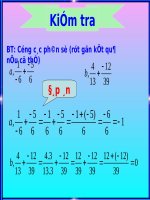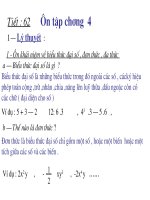Bài giảng chapter 6 condenser
Bạn đang xem bản rút gọn của tài liệu. Xem và tải ngay bản đầy đủ của tài liệu tại đây (1.36 MB, 31 trang )
CHAPTER 6: CONDENSER
Lecturer : ThS.Nguyễn Duy Tuệ
12/2015
Chapter 6: Condenser - ThS.Nguyễn Duy Tuệ
1
OBJECTIVES
In this chapter,
chapter student
st dent can:
can
-Understand principle of some kind of condensers
-Calculate
Calculate and chose the condenser met the
required capacity
12/2015
Chapter 6: Condenser - ThS.Nguyễn Duy Tuệ
2
REFERENCES
[1]. Trane document
[1]
doc ment
[2]. Kỹ thuật lạnh cơ sở - Nguyễn Đức Lợi
12/2015
Chapter 6: Condenser - ThS.Nguyễn Duy Tuệ
3
CONTENT
AIR COOLED CONDENSER
EVAPORATIVE CONDENSER
WATER COOLED CONDENSER
CONDENSER CALCULATION
12/2015
Chapter 6: Condenser - ThS.Nguyễn Duy Tuệ
4
AIR COOLED CONDENSER
- The condenser is a heat exchanger that rejects
heat from the refrigerant to air,
air water,
water or some other
fluid.
- The three common types of condensers are air
aircooled, water-cooled, and evaporative.
12/2015
Chapter 6: Condenser - ThS.Nguyễn Duy Tuệ
5
AIR COOLED CONDENSER
- A typical air-cooled condenser uses propellertype fans to draw outdoor air over a finned-tube
finned tube
heat transfer surface.
- The temperature difference between the hot
refrigerant vapor and the cooler outdoor air induces
heat transfer. The resulting reduction in the heat
content of the refrigerant vapor causes it to
condense into liquid.
- Within
Withi the
th final
fi l few
f
l
lengths
th off condenser
d
t bi
tubing
(the subcooler), the liquid refrigerant is further
cooled below the temperature at which it was
condensed.
12/2015
Chapter 6: Condenser - ThS.Nguyễn Duy Tuệ
6
AIR COOLED CONDENSER
12/2015
Chapter 6: Condenser - ThS.Nguyễn Duy Tuệ
7
AIR COOLED CONDENSER
Air cooled condenser without fan
12/2015
Chapter 6: Condenser - ThS.Nguyễn Duy Tuệ
8
AIR COOLED CONDENSER
+ Advantage :
- It requires very little maintenance and does not
require the freeze protection and water treatment
that is necessary with a water
water-cooled
cooled condenser.
- It is favored in areas that have an inadequate or
costly water supply, or where the use of water for air
conditioning is restricted.
+ Disadvantage : High condensing pressure
12/2015
Chapter 6: Condenser - ThS.Nguyễn Duy Tuệ
9
EVAPORATIVE CONDENSER
A modification of the air-cooled condenser is the
evaporative
ti
condenser.
d
Withi this
Within
thi device,
d i
th
the
refrigerant flows through tubes and air is drawn or
blown over the tubes by a fan.
fan The difference is that
water is sprayed on the tube surfaces. As the air
passes over the coil,, it causes a small p
p
portion of the
water to evaporate. This evaporation process
absorbs heat from the coil, causing the refrigerant
vapor within the tubes to condense. The remaining
water then falls to the sump to be recirculated and
used again.
again
12/2015
Chapter 6: Condenser - ThS.Nguyễn Duy Tuệ
10
EVAPORATIVE CONDENSER
We can subcool the liquid by using some length
of pipe submerged in the water sump or on the
path of air flow
12/2015
Chapter 6: Condenser - ThS.Nguyễn Duy Tuệ
11
EVAPORATIVE CONDENSER
+ Evaporative condenser without fan :
Water poured from the top to the surface of
tube; then evaporate by adding heat from
condenser. Hot water drop
p to the sump;
p; and drain
out partly; then it is compensated by cool wate
12/2015
Chapter 6: Condenser - ThS.Nguyễn Duy Tuệ
12
EVAPORATIVE CONDENSER
12/2015
Chapter 6: Condenser - ThS.Nguyễn Duy Tuệ
13
WATER COOLED CONDENSER
- The shell-and-tube is the most common type
of water-cooled condenser. With this design, water
is pumped through the tubes while the refrigerant
vapor fills the shell space surrounding the tubes.
tubes
- As heat is transferred from the refrigerant to
the water,
water the refrigerant vapor condenses on the
tube surfaces. The condensed liquid refrigerant
then falls to the bottom of the shell.
12/2015
Chapter 6: Condenser - ThS.Nguyễn Duy Tuệ
14
WATER COOLED CONDENSER
+ Shell-tube water cooled condenser
12/2015
Chapter 6: Condenser - ThS.Nguyễn Duy Tuệ
15
WATER COOLED CONDENSER
- After the warm water leaves the condenser, it
must either be disposed of (as in the case of using
water from a well) or it must be cooled before it
can be reused by the condenser.
condenser In this example,
example
the condenser brings in [29°C] water and warms it
up to [35
[35°C]
C]. Before this water can be used again,
again
it must be cooled back down to [29°C].
12/2015
Chapter 6: Condenser - ThS.Nguyễn Duy Tuệ
16
WATER COOLED CONDENSER
12/2015
Chapter 6: Condenser - ThS.Nguyễn Duy Tuệ
17
WATER COOLED CONDENSER
12/2015
Chapter 6: Condenser - ThS.Nguyễn Duy Tuệ
18
WATER COOLED CONDENSER
+ Vertical shell-tube condenser :
12/2015
Chapter 6: Condenser - ThS.Nguyễn Duy Tuệ
19
WATER COOLED CONDENSER
+Vertical shell-tube condenser:
12/2015
Chapter 6: Condenser - ThS.Nguyễn Duy Tuệ
20
WATER COOLED CONDENSER
+ Tube in tube water cooled condenser:
compact but it is difficult to clean out scale inside
compact,
12/2015
Chapter 6: Condenser - ThS.Nguyễn Duy Tuệ
21
WATER COOLED CONDENSER
+ Plate condenser :
- The refrigerant enters at top left of the
exchanger as hot gas and starts to condense on the
surface of the channels until fullyy condensed,, and is
then slightly subcooled. The process is called "free
condensation".
- In
I the
h enclosed
l
d condenser
d
picture
i
the
h light
li h
and dark blue arrows show the location of the brine
connections The refrigerant flows counter current in
connections.
the opposite channel and is cooled. The light and
dark red arrows indicate the locations of the
refrigerant connections.
12/2015
Chapter 6: Condenser - ThS.Nguyễn Duy Tuệ
22
WATER COOLED CONDENSER
.
12/2015
Chapter 6: Condenser - ThS.Nguyễn Duy Tuệ
23
WATER COOLED CONDENSER
+ Advantage of PHX:
- Compact and high efficiency
- Easy to increase capacity by inserting plates
into that;; and vice versa
+ Disadvantage :
- Not easy to clean out water scale
12/2015
Chapter 6: Condenser - ThS.Nguyễn Duy Tuệ
24
CONDENSER CALCULATION
1/ Condenser heat transfer area calculation:
Energy balance equation:
Qk=k.F.∆T , (W)
k : Overal heat transfer coefficient,, ((W/m2.K ) .
(We can use the experience of design table )
F : heat transfer area, (m2)
∆T
T : logarit
l
i temperature difference
diff
+ Note : We assume that water in and out are
equal with evaporative condenser
∆T=tk-tw
12/2015
Chapter 6: Condenser - ThS.Nguyễn Duy Tuệ
25









